The molecular structure of pillar[n]arene could serve different roles in the fabrication of attractive carbon nanotube-based materials. Firstly, pillar[n]arene has the ability to provide the structural basis for enlarging the cylindrical pillar-like architecture by forming one-dimensional, rigid, tubular, oligomeric/polymeric structures with aromatic moieties as the linker or forming spatially “closed”, channel-like, flexible structures by perfunctionalizing with peptides and with intramolecular hydrogen bonding. Interestingly, such pillar[n]arene-based carbon nanotube-resembling structures were used as porous materials for the adsorption and separation of gas and toxic pollutants, as well as for artificial water channels and membranes. In addition to the art of organic synthesis, self-assembly based on pillar[n]arene, such as self-assembled amphiphilic molecules, is also used to promote and control the dispersion behavior of carbon nanotubes in solution. Furthermore, functionalized pillar[n]arene derivatives integrated carbon nanotubes to prepare advanced hybrid materials through supramolecular interactions, which could also incorporate various compositions such as Ag and Au nanoparticles for catalysis and sensing.
- pillar[n]arene
- carbon nanotube
- synthesis
- hybrid materials
- composites
1. Mimicking the Structure and Characteristics of Carbon Nanotubes by Functionalized Pillar[n]arene
1.1. Preparing Linear Pillar[n]arene-Based Oligomer/Polymer via Rigid Aromatic Bridges
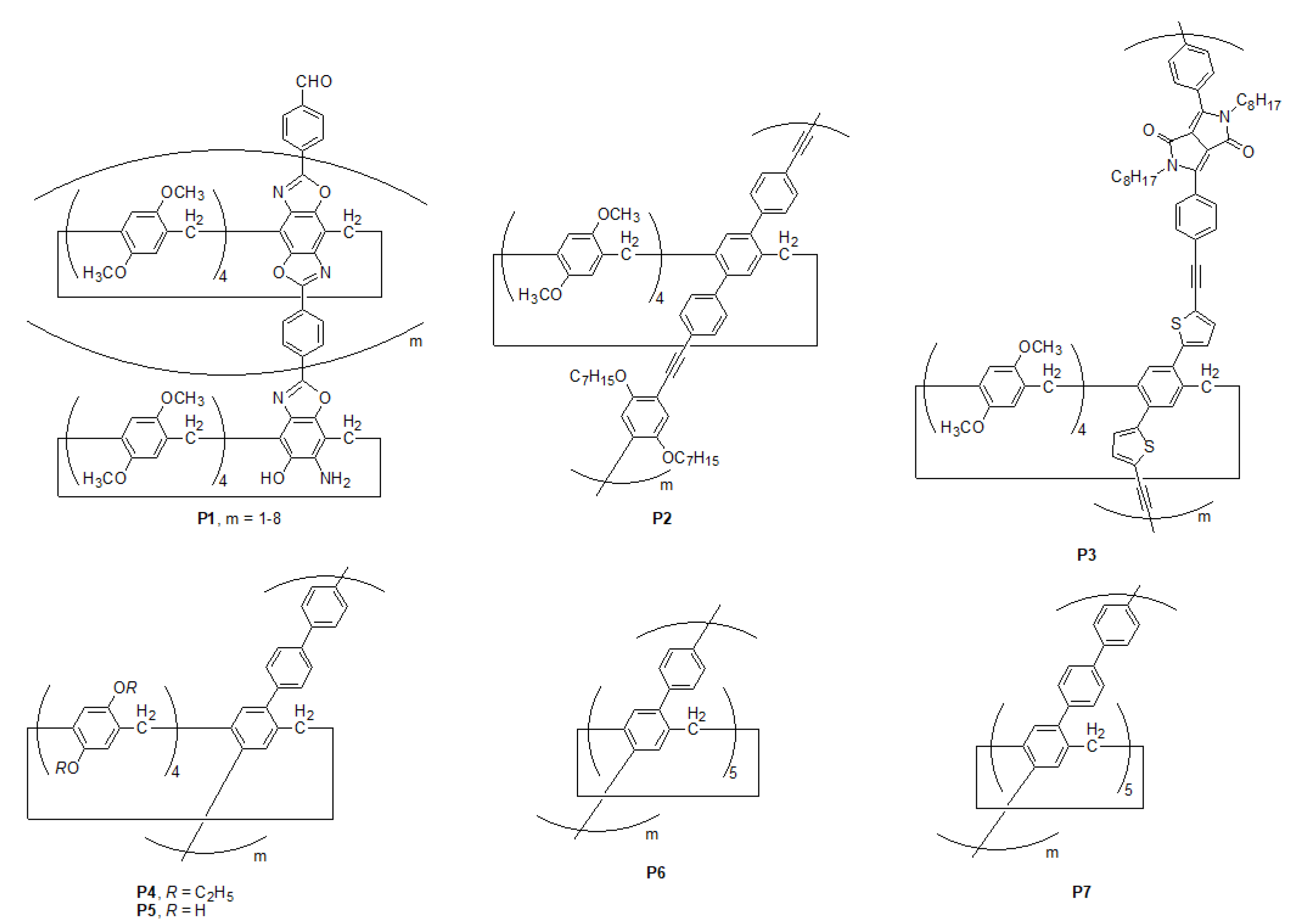
1.2. Preparing Peptide-Appended Pillar[n]arene Processing Intramolecular Hydrogen Bonds
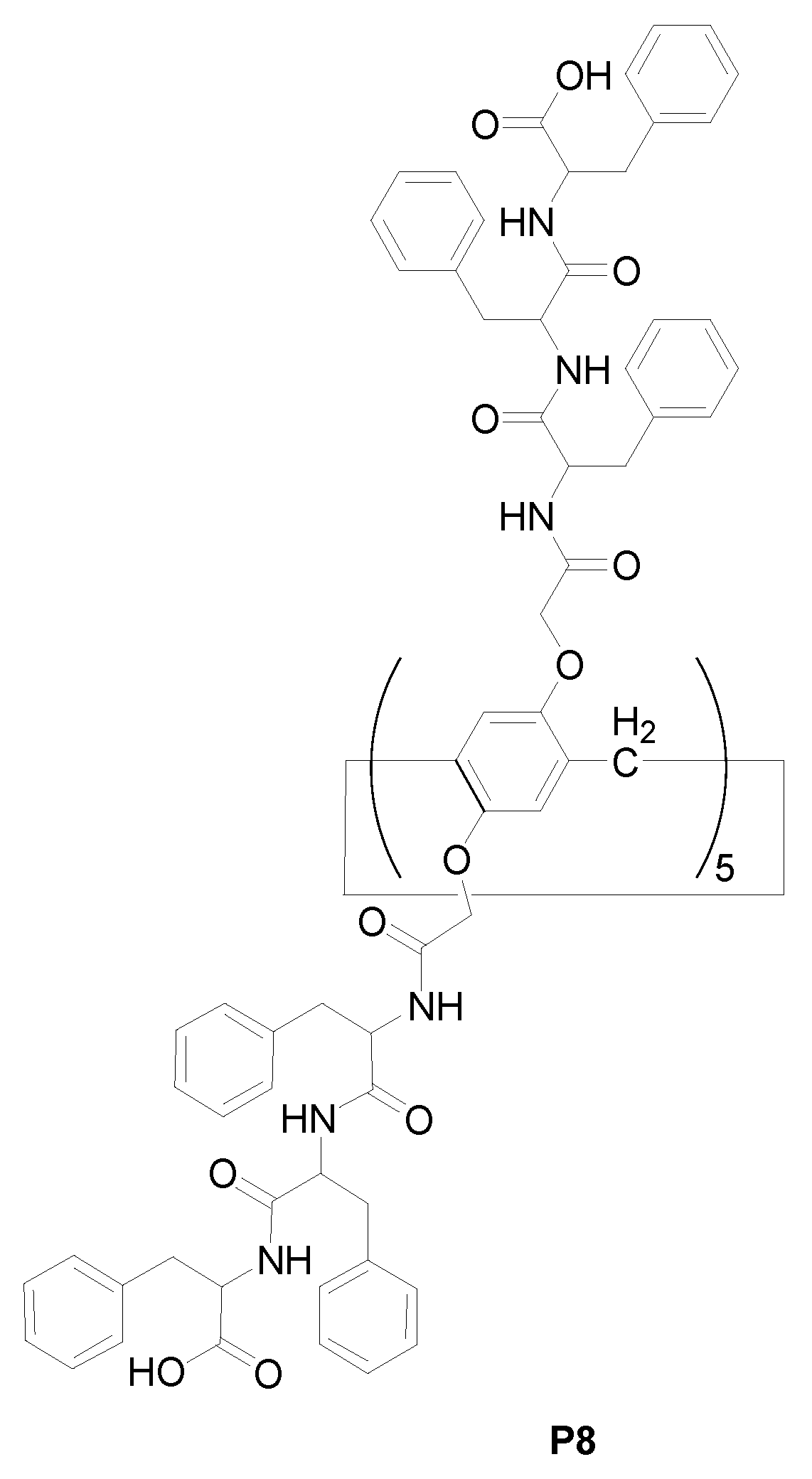
2. Dispersion of Carbon Nanotube by Using Functionalized Pillar[n]arene
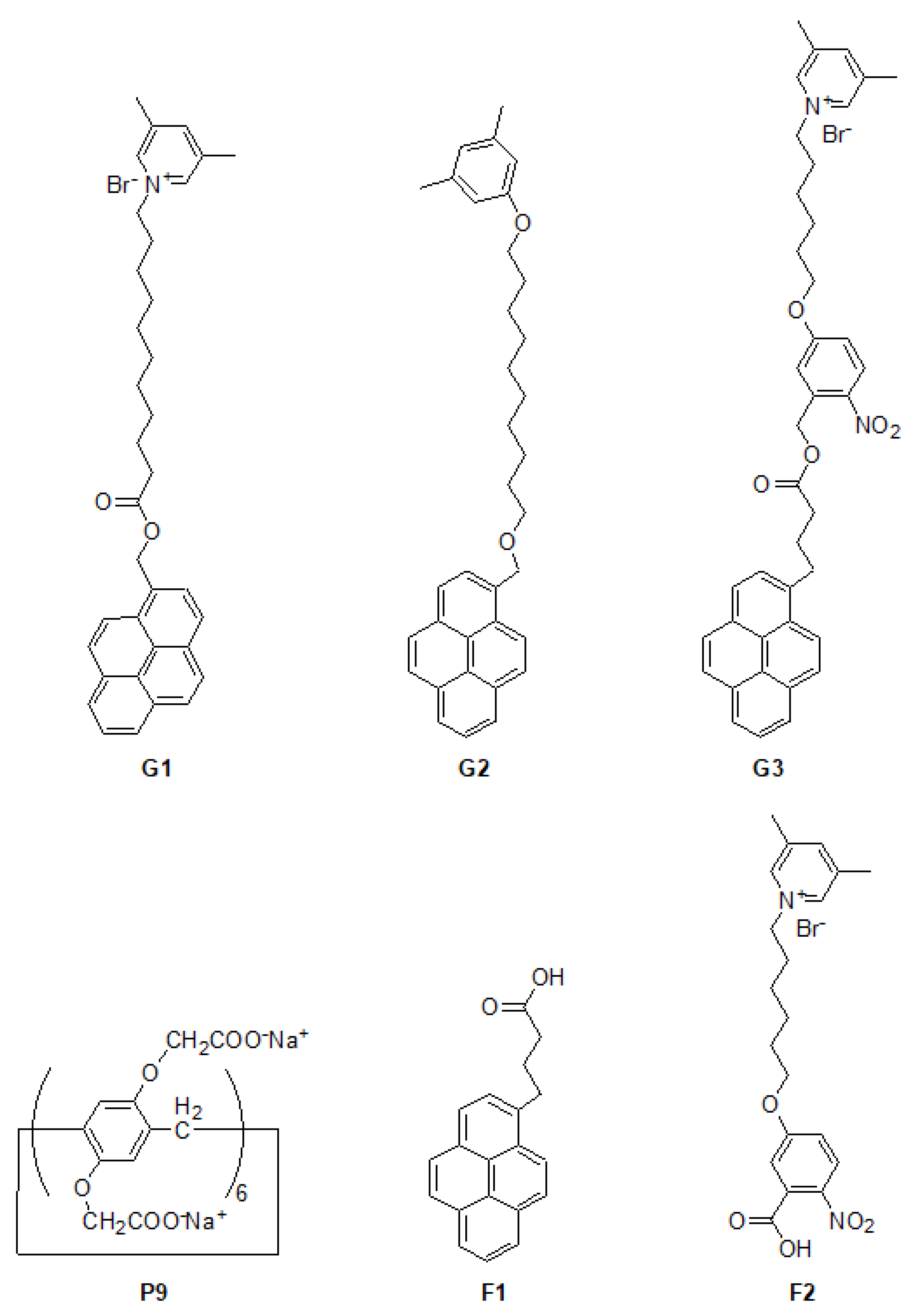
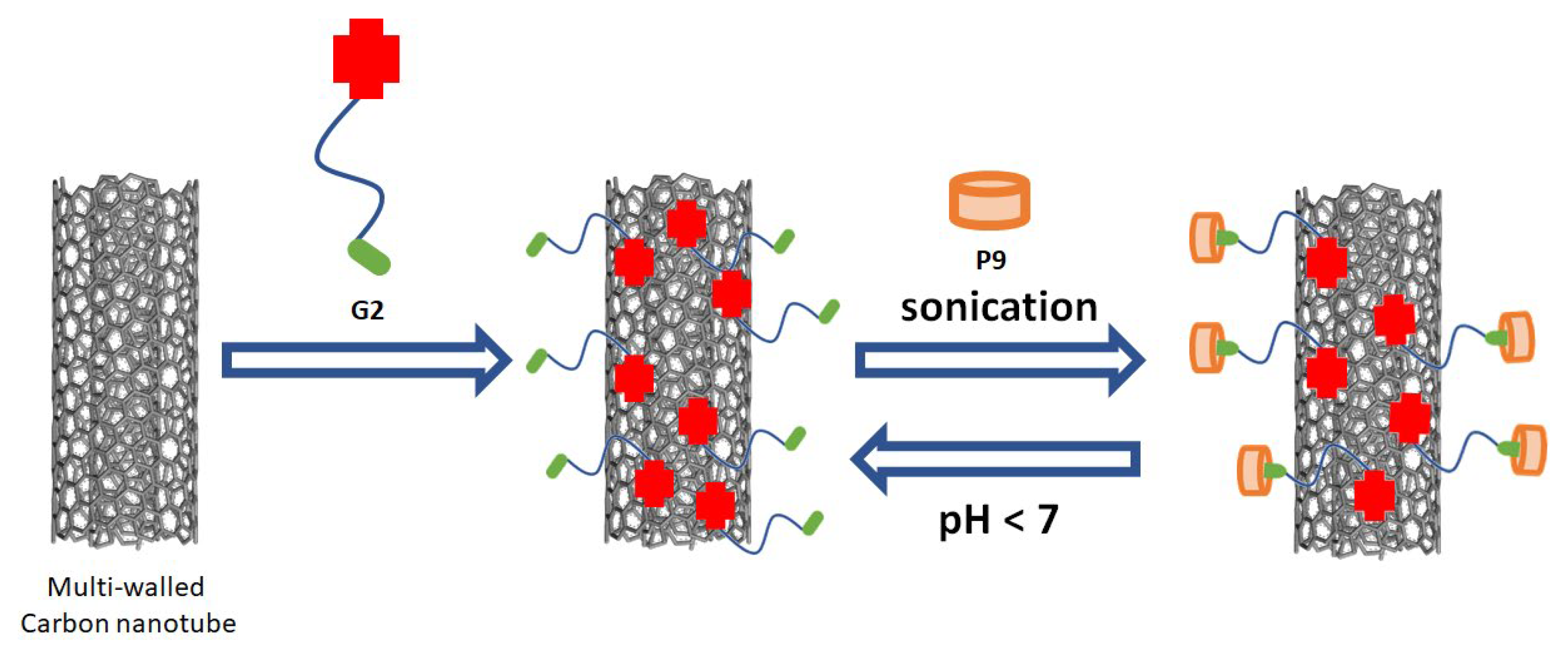
3. Decoration of Carbon Nanotube by Using Functional Pillar[n]arene


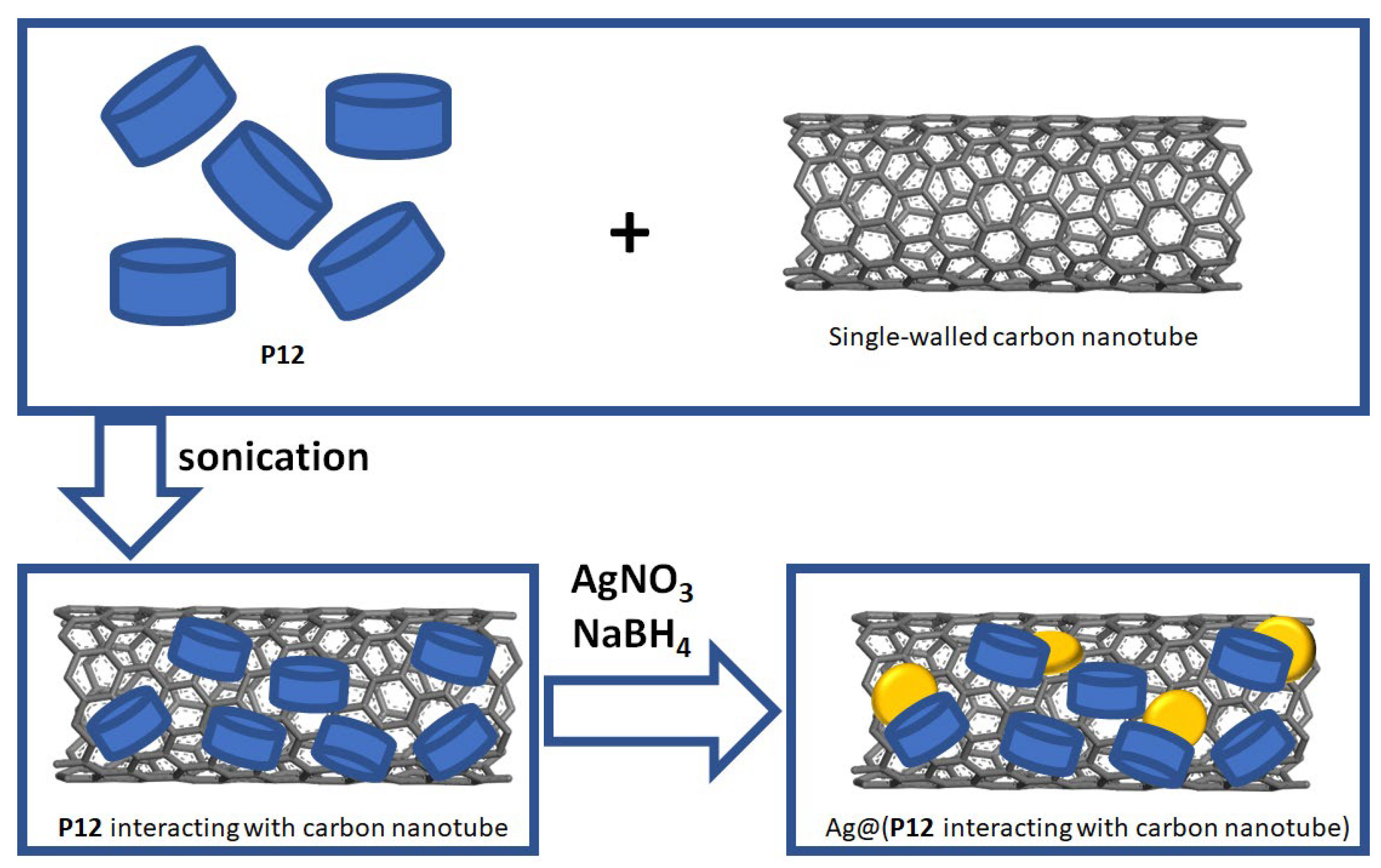
This entry is adapted from the peer-reviewed paper 10.3390/ma15176119
References
- Zhang, H.C.; Han, J.; Li, C. Pillararene-based conjugated porous polymers. Polym. Chem. 2021, 12, 2808–2824.
- Talapaneni, S.N.; Kim, D.; Barin, G.; Buyukcakir, O.; Je, S.H.; Coskun, A. Pillararene based conjugated microporous polymers for propane/methane separation through host-guest complexation. Chem. Mater. 2016, 28, 4460–4466.
- Strutt, N.L.; Zhang, H.; Schneebeli, S.T.; Stoddart, J.F. Amino-functionalized pillararene. Chem. Eur. J. 2014, 20, 10996–11004.
- Ma, Y.J.; Chen, L.; Li, C.; Müllen, K. A fishing rod-like conjugated polymer bearing pillararenes. Chem. Commun. 2016, 52, 6662–6664.
- Cui, W.; Tang, H.; Xu, L.X.; Wang, L.Y.; Meier, H.; Cao, D.R. Pillararene-diketopyrrolopyrrole fluorescent copolymer: A promising recognition and adsorption material for adiponitrile by selective formation of a conjugated polypseudorotaxane. Macromol. Rapid Commun. 2017, 38, 1700161.
- Ogoshi, T.; Shimada, Y.; Akutsu, T.; Yamagishi, T. A rod-like phenolic π-conjugated polymer with pillararene units in its main chain. Polymer 2017, 128, 325–329.
- Dennis, J.M.; White, N.A.; Liu, R.Y.; Buchwald, S.L. Pd-catalyzed C–N coupling reactions facilitated by organic bases: Mechanistic investigation leads to enhanced reactivity in the arylation of weakly binding amines. ACS Catal. 2019, 9, 3822–3830.
- Xu, S.Q.; Kim, E.H.; Wei, A.; Negishi, E. Pd- and Ni-catalyzed cross-coupling reactions in the synthesis of organic electronic materials. Sci. Technol. Adv. Mater. 2014, 15, 044201.
- Wang, D.; Gao, S.H. Sonogashira coupling in natural product synthesis. Org. Chem. Front. 2014, 1, 556–566.
- Blangetti, M.; Rosso, H.; Prandi, C.; Deagostino, A.; Venturello, P. Suzuki-miyaura cross-coupling in acylation reactions, scope and recent developments. Molecules 2013, 18, 1188–1213.
- Li, J.R.; Kuppler, R.J.; Zhou, H.C. Selective gas adsorption and separation in metal-organic frameworks. Chem. Soc. Rev. 2009, 38, 1477–1504.
- Li, H.; Wen, C.Y.; Zhang, Y.W.; Wu, D.P.; Zhang, S.L.; Qiu, Z.J. Accelerating gas adsorption on 3D percolating carbon nanotubes. Sci. Rep. 2016, 6, 21313.
- Gupta, V.K.; Saleh, T.A. Sorption of pollutants by porous carbon, carbon nanotubes and fullerene- an overview. Environ. Sci. Pollut. Res. 2013, 20, 2828–2843.
- Chen, L.; Si, W.; Zhang, L.; Tang, G.F.; Li, Z.T.; Hou, J.L. Chiral selective transmembrane transport of amino acids through artificial channels. J. Am. Chem. Soc. 2013, 135, 2152–2155.
- Hua, B.; Shao, L.; Zhang, Z.H.; Liu, J.Y.; Huang, F.H. Cooperative silver ion-pair recognition by peralkylated pillararenes. J. Am. Chem. Soc. 2019, 141, 15008–15012.
- Zhang, H.C.; Zhao, Y.L. Chapter 9: Supramolecular assemblies from pillararenes (micellar, vesicular and tubular formations). In Pillararenes; Ogoshi, T., Ed.; The Royal Society of Chemistry: Kanazawa, Japan, 2016; pp. 208–228.
- Strutt, N.L.; Zhang, H.; Schneebeli, S.T.; Stoddart, J.F. Functionalizing Pillararenes. Acc. Chem. Res. 2014, 47, 2631–2642.
- Xin, P.Y.; Kong, H.Y.; Sun, Y.H.; Zhao, L.Y.; Fang, H.D.; Zhu, H.F.; Jiang, T.; Guo, J.J.; Zhang, Q.; Dong, W.P.; et al. Artificial K+ channels formed by pillararene-cyclodextrin hybrid molecules: Tuning cation selectivity and generating membrane potential. Angew. Chem. Int. Ed. 2019, 58, 2779–2784.
- Shen, Y.x.; Si, W.; Erbakan, M.; Decker, K.; De Zorzi, R.; Saboe, P.O.; Kang, Y.J.; Majd, S.; Butler, P.J.; Walz, T.; et al. Highly permeable artificial water channels that can self-assemble into two-dimensional arrays. Proc. Natl. Acad. Sci. USA 2015, 112, 9810–9815.
- Barden, D.R.; Vashisth, H. Water dynamics in a peptide-appended pillararene artificial channel in lipid and biomimetic membranes. Front. Chem. 2021, 9, 753635.
- Kali, R.; Milner, S.T. Hydration shell stripping governs ion rejection in PAP water channels. Mol. Syst. Des. Eng. 2022, 7, 809–819.
- Li, M.H.; Lou, X.Y.; Yang, Y.W. Pillararene-based molecular-scale porous materials. Chem. Commun. 2021, 57, 13429–13447.
- Liu, Y.; Vashisth, H. Conformational dynamics and interfacial interactions of peptide-appended pillararene water channels in biomimetic membranes. Phys. Chem. Chem. Phys. 2019, 21, 22711–22721.
- Shen, Y.x.; Song, W.; Barden, D.R.; Ren, T.; Lang, C.; Feroz, H.; Henderson, C.B.; Saboe, P.O.; Tsai, D.; Yan, H.; et al. Achieving high permeability and enhanced selectivity for angstrom-scale separations using artificial water channel membranes. Nat. Commun. 2018, 9, 2294.
- Zhang, H.C.; Ma, X.; Nguyen, K.T.; Zeng, Y.F.; Tai, S.H.; Zhao, Y.L. Water-soluble pillararene-functionalized graphene oxide for in vitro raman and fluorescence dual-mode imaging. ChemPlusChem 2014, 79, 462–469.
- Shurpik, D.N.; Aleksandrova, Y.I.; Mostovaya, O.A.; Nazmutdinova, V.A.; Zelenikhin, P.V.; Subakaeva, E.V.; Mukhametzyanov, T.A.; Cragg, P.J.; Stoikov, I.I. Water-soluble pillararene sulfo-derivatives self-assemble into biocompatible nanosystems to stabilize therapeutic proteins. Bioorg. Chem. 2021, 117, 105415.
- Zhang, H.C.; Liu, Z.N.; Zhao, Y.L. Pillararene-based self-assembled amphiphiles. Chem. Soc. Rev. 2018, 47, 5491–5528.
- Zhang, H.C.; Zhao, Y.L. Pillararene-based assemblies: Design principle, preparation and applications. Chem. Eur. J. 2013, 19, 16862–16879.
- Cao, S.; Zhou, L.; Liu, C.; Zhang, H.C.; Zhao, Y.X.; Zhao, Y.L. Pillararene-based self-assemblies for electrochemical biosensors. Biosens. Bioelectron. 2021, 181, 113164.
- Yu, G.C.; Xue, M.; Zhang, Z.B.; Li, J.Y.; Han, C.Y.; Huang, F.H. A water-soluble pillararene: Synthesis, host-guest chemistry, and its application in dispersion of multiwalled carbon nanotubes in water. J. Am. Chem. Soc. 2012, 134, 13248–13251.
- Liu, Y.M.; Zhou, F.; Yang, F.; Ma, D. Carboxylated pillararene (n = 5–7) host molecules: High affinity and selective binding in water. Org. Biomol. Chem. 2019, 17, 5106–5111.
- Billing, B.K.; Agnihotri, P.K.; Singh, N. Development of pyrene-stacked carbon nanotube-based hybrid: Measurement of NO3− ions using fluorescence spectroscopy. Analyst 2018, 143, 3343–3352.
- Hua, Y.J.; Chen, L.; Hou, C.X.; Liu, S.B.; Pei, Z.C.; Lu, Y.C. Supramolecular vesicles based on amphiphilic pillararenes for smart nano-drug delivery. Int. J. Nanomed. 2020, 15, 5873–5899.
- Colombo, F.; Norton, E.G.; Cocucci, E. Microscopy approaches to study extracellular vesicles. Biochim. Biophys. Acta Gen. Subj. 2021, 1865, 129752.
- Chen, T.; Li, M.X.; Liu, J.Q. π–π stacking interaction: A nondestructive and facile means in material engineering for bioapplications. Cryst. Growth Des. 2018, 18, 2765–2783.
- Haddad, R.; Holzinger, M.; Maaref, A.; Cosnier, S. Pyrene functionalized single-walled carbon nanotubes as precursors for high performance biosensors. Electrochim. Acta 2010, 55, 7800–7803.
- Yang, J.; Yu, G.C.; Xia, D.Y.; Huang, F.H. A pillararene-based UV-responsive supra-amphiphile: Synthesis, self-assembly, and application in dispersion of multiwalled carbon nanotubes in water. Chem. Commun. 2014, 50, 3993–3995.
- Novo, M.; Freire, S.; Al Soufi, W. Critical aggregation concentration for the formation of early amyloid-β (1-42) oligomers. Sci. Rep. 2018, 8, 1783.
- Shamshoom, C.; Fong, D.; Li, K.; Kardelis, V.; Adronov, A. Pillararene-decorated single-walled carbon nanotubes. ACS Omega 2018, 3, 13935–13943.
- Zeng, L.P.; Lin, X.X.; Li, P.; Liu, F.Q.; Guo, H.; Li, W.H. Recent advances of organogels: From fabrications and functions to applications. Prog. Org. Coat. 2021, 159, 106417.
- Wei, T.B.; Zhao, Q.; Li, Z.H.; Dai, X.Y.; Niu, Y.B.; Yao, H.; Zhang, Y.M.; Qu, W.J.; Lin, Q. Supramolecular organogel with aggregation-induced emission for ultrasensitive detection and effective removal of Cu2+ and Hg2+ from aqueous solution. Dyes Pigm. 2021, 192, 109436.
- Esposito, C.L.; Kirilov, P.; Roullin, V.G. Organogels, promising drug delivery systems: An update of state-of-the-art and recent applications. J. Control. Release 2018, 271, 1–20.
- Zhao, G.F.; Gao, Z.H.; Li, H.N.; Liu, S.M.; Chen, L.J.; Zhang, R.L.; Guo, H. Controlled assembly of Ag nanoparticles on the surface of phosphate pillararene functionalized single-walled carbon nanotube for enhanced catalysis and sensing performance. Electrochim. Acta 2019, 318, 711–719.
- Borjigin, T.; Zhao, G.F.; Zhang, Y.H.; Liang, M.F.; Liu, B.H.; Liu, H.; Yang, X.F.; Guo, H. Control loading au nanoparticles on the surface of hydroxyl pillararene functionalized single-walled carbon nanotubes and its application in catalysis and sensing. Sustain. Energy Fuels 2019, 3, 2312–2320.
- Liu, Z.N.; Liu, W.B.; Huang, Y.Z.; Zhang, H.C. Facile fabrication of free-standing Cu2O-Au nanocomposite on Cu foil for high performance glucose sensing. J. Alloys Compd. 2020, 848, 156532.
- Zhu, H.T.Z.; Shangguan, L.Q.; Huang, F.H. Multi-functional pillararene-stabilized gold nanoparticles. Matter 2019, 1, 788–789.
- Li, P.y.; Chen, Y.; Chen, C.h.; Liu, Y. Multi-charged bis(p-calixarene)/pillararene functionalized gold nanoparticles for ultra-sensitive sensing of butyrylcholinesterase. Soft Matter 2019, 15, 8197–8200.
